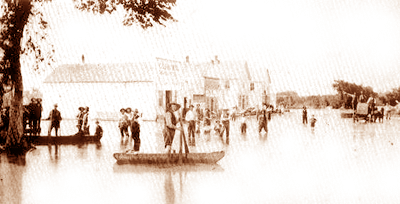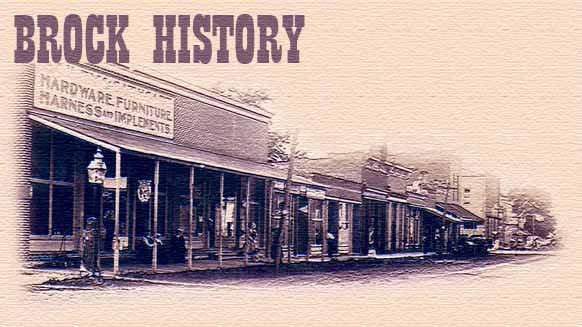|
arly maps show a town, Dayton, near where
the Nebraska City-Blue River trail crossed the Nemaha River. Andreas, in
his 1882 History of Nebraska, reported that Lawrence KENNISON was
appointed postmaster at Dayton in 1856. George SHROAF with a soldier's
warrant acquired the northeast one-fourth of Section-16 and built a log
cabin a little above the Nemaha Crossing in 1855. This became known as "SHROAF's
Ford."
Somewhat later Howard BRADLEY occupied this
cabin. To attract trade from the south side of the river – especially
the German settlement on the Muddy – a bridge was built by a Nebraska
City merchant. This was referred to as "Bradley's Bridge." He kept the
mail, which arrived from Nebraska City once a week, in a shoe box until
called for. He also kept a few supplies. The post office and the
settlement took BRADLEY's first name, Howard.
About 1880, the Post Office Department
requested that the name be changed because of the similarity to Harvard.
Several names were suggested, but when the petition reached Washington,
it contained the name Podunk. When the railroad arrived, the station was
given the name Brock in honor of a railroad official.
D.C. SANDERS came in 1867 and built a crude
dam and a gristmill powered by the waterfall. A sawmill was added in
1870, but was closed after the operator was fatally injured when he came
in contact with the running saw.
The mill, then on the north side, was
purchased by Jonathan HIGGINS and enlarged. It was later sold to William
STARR and William HAWLEY. During these days the mill flourished and was
a very popular place of business among the settlers for miles around.
About this same time, John BROWN arrived and
started a small store on the south side of the river. When J.M. CAMPBELL
came in 1871, he bought the store from Mr. BROWN, and was appointed
postmaster.
In 1878, Mr. CAMPBELL purchased some land
from J. HIGGINS south of the river and had it laid off in town lots, and
from this time the town began to flourish. A blacksmith shop was
started.
Mr. Alex WRIGHT, who arrived in 1880, bought
a 35-acre plot of land south of the bridge for $100, and laid it off in
town lots. Most of these lots he sold for $10, but one sold for $100.
WRIGHT's addition to the town was called Clinton. This name, however,
was never an official name of the post office. Clinton was the town that
grew "on the hill," and had, for some time, stores, a church, and
several dwellings.
The coming of the Missouri Pacific Railroad
in 1881 was a happy event, for until this time all supplies had to be
hauled from Nebraska City. From Andreas’ History, we learn that soon
after the arrival of the railroad, there were four general stores, a
hardware, a drug store, two doctors, a lumber yard, two blacksmith
shops, a shoe store, a meat market, a restaurant, two hotels, two livery
stables, and a harness shop.
Early citizens of Brock and vicinity had a
peculiar way of reckoning time – "before or after the flood." The Nemaha
River periodically overflowed and flooded the valley from bluff to
bluff. In the spring of 1883, the river overflowed at two different
times, going above all previously
 known
high water marks. Many were convinced it would be wise to move to the
hill, and did so. known
high water marks. Many were convinced it would be wise to move to the
hill, and did so.
Despite
straightening the channel in 1912, there were times when the river could
not carry the flow from extensive rain-fall and cloud-bursts on the
upper Nemaha watershed. Subsequent floods oc-curred in 1924, 1928, 1941,
and in 1951. Since the time of the last flood, such danger has decreased
appreciably due to soil conservation practices.
The first church in Brock was the Baptist
Church, which was built in 1882 and dedicated in the fall. The Methodist
Church, built in 1883, was a frame structure which was used for worship
for forty years. To accommodate the growing congregation, this church
was remodeled and rededicated in 1913. A United Brethren Church was
built in the south part of Brock about 1891, and flourished a few years.
It was moved to the north part of town, and later the building was sold.
The Christian Church was built in 1893, rebuilt and enlarged in 1913,
and again remodeled in 1960.
All
village children south of the Nemaha attended Rosewood school from 1868
until 1873, when Union schoolhouse was built a half mile west of town.
In 1884, a two-story frame building was built on the site of the present
school. Then, in 1905, a new brick structure was built to replace
inadequate facilities. In November 1925, this schoolhouse burned,
leaving the students to attend classes in make-shift facilities until
the new fireproof brick building could be erected. This was dedicated in
1927.
Ô |

